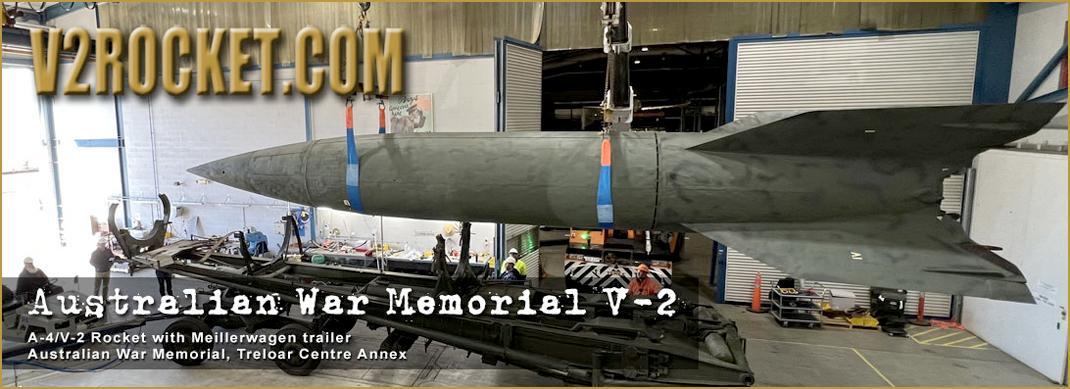A-4/V-2
Rocket and Meillerwagen
AWM Museum Storage at Treloar Technology
Annex, Mitchell, Canberra
Special thanks to Alan Scheckenbach
& Stan
Druzynski
In 1947, Australia received two
separate shipments of V-2 rockets from
the United Kingdom which arrived only
months apart. Both V-2s were mounted
on German Vidalwagen transport
trailers when they arrived.
Additionally, a complete Meillerwagen
and other German equipment accompanied
the second rocket.
FIRST
V-2
The first V-2 and Vidalwagen
were shipped as deck cargo aboard the MV Karamea. This V-2 left Britain in February
1947 and arrived at Port Melbourne in late
March. In order to preserve the V-2
throughout the ocean voyage to Australia,
the rocket was wrapped in canvas and coated
with tar because it was attached to the deck
and exposed to the elements. The Vidalwagen
and V-2 were immediately sent on to
Monegeetta, north of Melbourne, to the Royal
Australian Army Engineer’s testing ground.
The purpose of this was to perform a series
of technical evaluations. As far as it is
known, this V-2 was technically complete
although photographs at Monegeetta reveal a
large square hole was cut in the side of the
center section at some point to expose the
central ends of the fuel tanks. When and
where this was done is unknown.
While at the
Royal Australian Army Engineer’s
testing ground,
the rocket was cleaned of the preservative
and repainted from its original late-war
green to a white and black scheme.After the
evaluation, the rocket and Vidalwagen were
employed on the Third Security Loan rally.
From early April 1947, they were towed as
part of a small convoy along the Hume
Highway between Melbourne and Sydney
(roughly 500 miles/800 km) and were
displayed at numerous towns along the way.
After the publicity tour, the
rocket was transferred to the Army’s
Military History Section in Sydney on May 3,
1947. The materiel was then housed in the
Australian War Memorial’s Commonwealth
Stores Exhibition Building in Sydney. The
rocket was occasionally displayed publicly,
but for the most part, it remained in AWM
storage. In 1957, the V-2 and Vidalwagen
were pictured in Liverpool
before being displayed in front of the
Customs House in Sydney at Circular Quay.
-
PHOTOS BELOW SHOW FIRST V-2
AND VIDALWAGEN SHIPPED FROM LONDON FOR EVALUATION AT
RAAF
ARMY ENGINEER'S TESTING GROUND IN
MONEGEETTA
-
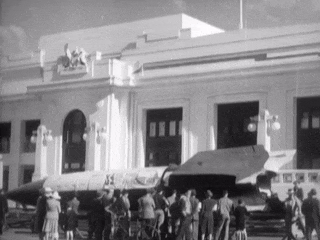
-
FIRST V-2 ON DISPLAY IN FRONT OF
PARLIAMENT HOUSE IN
CANBERRA DURING THE 1947 THIRD
SECURITY LOAN TOUR
- 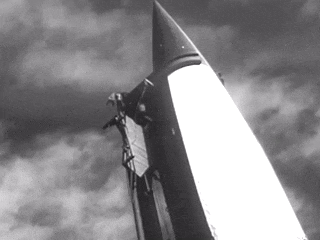 -
-
SECOND V-2 AND
MEILLERWAGEN DISPLAYED
AT SALISBURY
BEFORE THE ARMY AND LORD
MAYORS EXHIBIT IN
ADELAIDE 1948
|
SECOND V-2
The second V-2 to arrive
in Australia in 1947 was loaned to the
Australians by the British
authorities. It arrived at Port
Adelaide on October 12, 1947, on board
the SS Port Lincoln. This V-2 was
delivered lying atop another
Vidalwagen trailer, along with a rare
German Meillerwagen erector trailer.
Other related items in the second
consignment included a V-2 warhead,
carbon vanes, a LOX road
tanker/trailer, an extra combustion
chamber, a turbine assembly, steam
generator unit, and extra V-2 fuel
tanks. Also included was a Ruhrstahl
X-4 wire-guided air-to-air missile,
along with a complete Enzian
anti-aircraft missile.
The V-2, Vidalwagen, and
Meillerwagen, were taken to the Long
Range Weapons Research Establishment
(LRWE) at Salisbury in northern
Adelaide and placed into storage in
Store Number 2. The RAAF
Woomera range was
supported by LRWE in Salisbury. This
V-2 was an overall dark-green color
when it arrived from England. Sometime
around November 1, 1947, the officer
in charge of the Stores was instructed
to paint the V-2 in black and white
alternating segments. The other
equipment, specifically the
Vidalwagen, Meillerwagen and LOX road
tanker, were to be painted olive
green.
Photographic evidence
from the “Operation Backfire Report”
appears to confirm that both the first
and second V-2s came from the
stockpiles of German weapons collected
for the post-war evaluations of the
missile by the British in Cuxhaven,
Germany. Images and film from 1945
show various components labelled for
simple identification within one of
the V-2 control compartments, which
is, identical to the rocket that ended
up in Salisbury.
In late January 1948, the
V-2 at Salisbury
was transferred from its Vidalwagen
onto the Meillerwagen. A few weeks
later officials agreed to loan the V-2
and Meillerwagen to the combined Army
and Lord Mayors Display in Adelaide
from February 4-7, 1948. Because the
rocket would be displayed with the
Meillerwagen lifted to a
45-degree
angle, the
Army leaders
explained that
the
Meillerwagen
needed to be
in good
operating
order. There
is no doubt
that the 1948
exposition was
a highlight in
the history of
this rocket.
|
The V-2
and Meillerwagen, as well as the Vidalwagen,
LOX trailer, and associated equipment, were
then stored for almost a decade. In March 1952
the V-2 and Meillerwagen were displayed at the
Royal Adelaide
showgrounds in Wayville, suburb of
Adelaide, where the V-2 was first seen painted
silver. The show featured technology and
progress exhibition including weapons, farm
machinery and communications, etc. In the mid
1950s, the V-2 was spotted again at a few
airshows held at RAAF Mallala. In October 1954
the V-2 and Meillerwagen were moved from LRWE
Store 2 to Building 12 of the
Maintenance Area. It is unknown
what happened to the LOX trailer, and other
components that were also stored in LRWE Store
2.
In January 1957,
the British
Department of
Supply, who
technically still
owned the LRWE V-2
in Salisbury,
considered
permanently
donating it to the
Australian War
Memorial. On June
24, 1957, a letter
was sent to the
AWM offering the
V-2 and
Meillerwagen,
which the AWM
gladly accepted.
However, a request
by the RAAF to
borrow the V-2 and
Meillerwagen
interrupted any
immediate plans to
move the
Meillerwagen and
V-2 to Canberra.
The artifacts were
wanted for an
upcoming display
during Air Force
Week at RAAF Base
Richmond, north of
Sydney in late
August 1957.
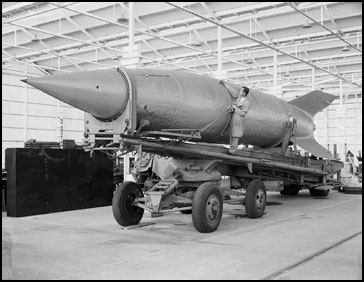
|
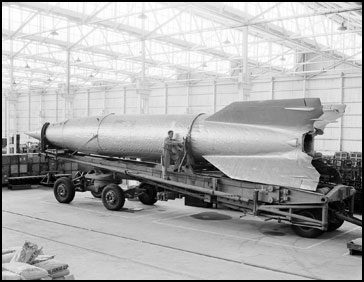
|
AWM V-2 AND MEILLERWAGEN AT
LRWE SALISBURY 1954 NAA 10681749
|
AWM V-2 PAINTED SILVER
STORED IN SALISBURY 1954 NAA 10681748
|
During
preparations for Air Force Week,
when the rocket was being lifted,
the hull section of the rocket was
broken directly above the tail
section. Hasty repairs had to be
made. A brace was welded into
place between the Meillerwagen and
the middle of the rocket’s tail to
straighten it, and a sheet-metal
girdle was riveted around the
lower part of the center section.
Because of these repairs, it
appears the rocket was repainted
once again in a (fictitious)
scheme of overall white with black
on the fin leading edges, black
where the two Meiller clamp bands
are situated, a yellow warhead and
red warhead tip. Soon after the
conclusion of Air Force Week, the
rocket and Meillerwagen finally
arrived in Canberra in October of
1957, where they were put into
storage at the Royal Military
College at Duntroon. The fate of
the second Vidalwagen is not
known.
Due to the recent
acquisition of the LRWE V-2 and
Meillerwagen by AWM, the original
V-2 and Vidalwagen, which had been
quietly stored in AWM sheds in
Sydney for ten years, were offered
to the 1st Field Regiment, Royal
Australian Artillery, Holsworthy
Barracks. The Army received the
rocket on May 19, 1958, and it was
displayed vertically as a “gate
guard” near the base entrance.
Whether the rocket was gutted
before or after being taken over
by the Army is unknown. Given that
its Vidalwagen trailer had been
cut into smaller sections and
buried in the base rubbish dump,
it is likely that the rocket
motor, fuel tanks, and guidance
system were also discarded there.
The shell of the
Holsworthy V-2 slowly deteriorated
over many years due to weather,
and even with multiple paint jobs,
it eventually got to the point
where it was severely rusted and
potentially dangerous. It is
possible that the Army decided to
get rid of the rocket because they
thought it reflected poorly on
them. On April 20, 1976, the Army
wrote to the Australian War
Memorial about disposing of the
shell. Even though the AWM
Director was eager to keep the V-2
from being destroyed, the AWM
stated they lacked storage space
in Canberra. Instead, he suggested
the rocket be offered to the Royal
Australian Air Force Museum in
Victoria. The RAAF Museum was
happy to receive the V-2 and soon
it was stored at the former No. 2
Stores Depot at Dubbo in central
western New South Wales where it
remained for almost a decade. In
the early nineties, when No. 2
Stores Depot closed down, it was
sent to the RAAF Museum at Point
Cook, to the southwest of
Melbourne.
In reality,
the Holsworthy V-2
was already a
complete shambles
when it arrived at
Point Cook. The
gutted rocket was
first displayed on
the tarmac, lying
on its side,
outside the old
Museum hangar
where it suffered
further exposure.
The shell exterior
was covered in
folds, dents, and
rust, giving it a
very tired
appearance. Later
it was stored in
one of the hangars
and treated
against further
corrosion. It was
eventually
disassembled to
make space in the
hangar.
THE POINT COOK V-2 AFTER IT WAS
RECOVERED FROM HOLSWORTHY ARMY BASE.
IT WAS ALREADY SEVERELY DETERIORATED
WHEN IT ARRIVED
|
|
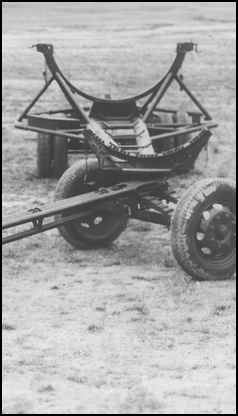
-
FIRST VIDALWAGEN AT RAAF ARMY
ENGINEER'S
TESTING GROUND IN MONEGEETTA
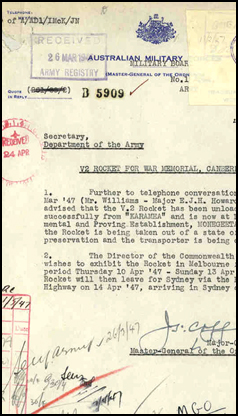
-
OFFICIAL DOCUMENT CONCERNING THE THIRD
SECURITY LOAN RALLY 1947 NAA669287
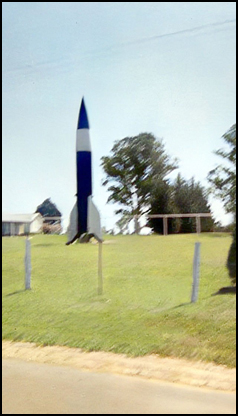
-
FIRST V-2 DISPLAYED VERTICALLY NEAR THE
ENTRANCE TO HOLSWORTHY ARMY BASE 1964
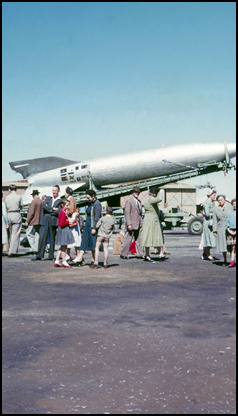
LRWE-AWM V-2 COLOR PHOTOGRAPH AT AIR
FORCE WEEK RAAF MALLALA MID FIFTIES MHS
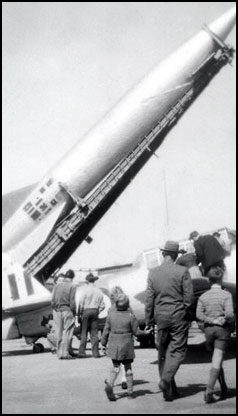
LRWE-AWM V-2 AND MEILLERWAGEN AT AIR
FORCE WEEK RAAF MALLALA MID FIFTIES
|
PHOTOS ABOVE SHOW THE POINT COOK V-2
OUTSIDE OF AWM TRELOAR ANNEX IN
CANBERRA WHERE IT REMAINED FOR ALMOST
TWENTY YEARS ENDURING EVEN MORE
INCLIMATE WEATHER CONDITIONS
|
Around
1995-2001, as
part of a
relic exchange
between the
RAAF Museum
and the
Australian War
Memorial, the
shell of the
V-2 at Point
Cook was
reassembled
and moved to
the AWM Museum
Storage at
Treloar
Technology
Annex in the
Canberra
suburb of
Mitchell. The
War Memorial’s
restoration
crew was
astounded to
see the sad
state of this
priceless
piece of
history. It
was left
installed on
its wooden
traveling
frame in the
Canberra
weather
because of its
already bad
state, a lack
of money, and
crowded
conditions in
the two big
warehouses. By
this point,
its value as
an authentic
exhibit was
dubious, and
visitors to
the annex
could only
wonder how the
rocket ever
got to this
miserable
condition.
The AWM V-2
and
Meillerwagen
were already
at the Treloar
Centre Annex,
having been
moved from
Duntroon in
1968. It was
intended that
the Point Cook
shell would be
used for study
and reference
when the AWM
V-2 was due
for further
conservation
and repair. —

CONSERVATION
AND RESTORATION 2021-2023
Finally, in 2021, the AWM
V-2 and Meillerwagen were moved into
the Treloar Centre main workshop with
the intention of repairing and
conserving them for semi-permanent
display in the main building of the
Australian War Memorial beginning in
2025. After the work began, it was
discovered the framework of the rocket
was significantly
corroded—particularly noticeable in
the middle section and in the rings
that connect the sections—despite
having been stored in seemingly
acceptable conditions since 1958.
It appears the corrosion
damage started on the sea voyage to
Australia when the V-2 was stored as
deck cargo. It sat outside at the
Salisbury research station for several
years while it was studied and then
was toured around and ended up in
Sydney where it was housed, being
brought out for occasional displays.
Rains had saturated the glass wool
insulation around the inside of the
hull, which retained the moisture and
caused the structure of the middle
section of the rocket to rust
severely. The rot was well advanced by
1957 when the RAAF broke the frame at
the rear bulkhead while trying to lift
it from the Vidalwagen onto the
Meillerwagen. Significant corrosion
was also found in the tail assembly
and what started out as conservation
soon became restoration.
The rocket was carefully
removed from the Meillerwagen in
sections. The tail unit was removed
first and mounted on a rotisserie,
followed by the rocket motor also
mounted on a jig. Then the warhead and
the control compartment sections were
removed. Lastly, the badly corroded
center section was lifted free. The
crews were surprised by the level of
corrosion found in the tail unit and
the hull sections. The decision was
made to repair the structure of the
tail unit. The structural integrity of
the hull was severely compromised, and
the end rings were irreversibly out of
round and not repairable. Remarkably,
a quick survey of the hull section of
the Point Cook V-2 revealed that it
was in better structural shape than
the AWM rocket. A decision was made to
utilize the center section of the Pont
Cook V-2 in the repair of the AWM V-2.
With the engine assembly
removed, repairs began immediately
with rotten skin being removed from
the tail unit and corroded sections of
the frame cut out and replaced with
precisely proportioned replacements
until the tail unit was structurally
sound. Around the control surfaces of
the tail unit, sections of the
original skin were treated for
corrosion and left in place and a new
skin was fitted over the top to
preserve as much of the original skin
as possible. A new skin was rolled and
attached in the same manner as the
original. All replaced sections were
marked and dated. The tail unit was
painted using a color found on the
surface and camouflaged using photos
of the rocket at Operation Backfire at
Cuxhaven. The center section of the
Point Cook V-2 was moved into the
workshop and mounted on a jig before
work commenced to replace corroded
sections. It was then re-skinned and
painted in the original paint and
camouflage scheme. All new metal and
the skin were marked as replaced by
the AWM.
The fuel tanks, warhead, and
control compartments were
dismantled, checked, preserved
if needed, and meticulously
catalogued. A new
warhead tip
was fashioned
and installed.
It was noted that only
one gyroscope was present
instead of the expected two.
It is unknown if it was never
in the original assembly for
Operation Backfire or whether
it was removed sometime later.
Some of the electronic
components in the control
compartment were incomplete,
leading to the conclusion that
as an Operation Backfire
technology demonstrator, this
V-2 needed to look operational
but not be operational.
The deficiency
may have been a result of a
shortage of electronic V-2
components in the British
Sector of occupied Germany in
1945. Other V-2s can be seen
in the Operation Backfire
photographs from Cuxhaven.
These rockets were also used
as technology demonstrators to
illustrate different sections
of the V-2, not related to the
control compartment.
Identification
numbers and
descriptions of
each function of
all important
parts on the V-2
were tagged and
seen in the final
report.
|
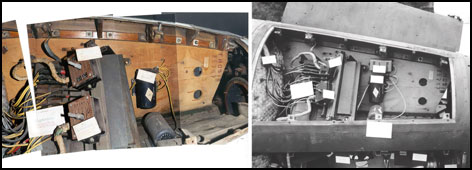
COMPARISON OF AWM V-2
CONTROL COMPARTMENT AND
PHOTO FROM OPERATION
BACKFIRE
|
The fuel tanks, warhead,
new warhead fuse tip, and control
compartments were dismantled, checked,
preserved if needed, and meticulously
catalogued. It was noted that only one
gyroscope was present instead of the
expected two. It is unknown if it was
never in the original assembly for
Operation Backfire or whether it was
removed sometime later. Some of the
electronic components in the control
compartment were incomplete, leading
to the conclusion that as an Operation
Backfire technology demonstrator, this
V-2 needed to look operational but not
be operational. This incompleteness
may have been a result of a shortage
of electronic V-2 components in the
British Sector.
-
PHOTOS BELOW: TEAR
DOWN AND RESTORATION WORK 2021-2023
After the Meillerwagen
was inspected, it was
discovered that internal
corrosion had severely
damaged the rear bogie’s
center structure, which
is located below the
rocket’s nose.
Additionally, the
outriggers were missing
their feet and the nose
jaws had disappeared.
The bogie was repaired,
new feet were
manufactured and new
nose jaws were
manufactured and fitted.
Overall, the
Meillerwagen is almost
complete with only minor
fittings like the side
platforms missing. By
far, it is the most
original and complete
Meillerwagen of the
three survivors. For use
in Operation Backfire,
the Meiller was
re-plumbed as far as
compressed air,
nitrogen, oxygen and
electric power for the
hydraulic pump, and then
repainted green over the
original German
Dunkelgelb
(dark-yellow). No
modifications were made
to the Meillerwagen in
Australia other than the
tail brace and the
removal of the nose
clamp jaws.
In 2023,
the rocket was
reassembled without the
motor, lifted and
secured onto the
repaired Meillerwagen. The rocket
currently resides in its
old resting place in
Treloar B. The motor has
been removed and will be
displayed alongside the
V-2/Meillerwagen combo
when they are moved into
a new gallery in the
Australian War Memorial
in 2025. Since the new
ANZAC Hall’s ceiling is
too low for a vertical
exhibition, the
Meillerwagen with V-2
will be displayed with
its arm lifted to a
roughly 22-degree angle.
|
|
The long history of the two Australian
rockets was a challenging timeline to
reconstruct. Due to the foresight of the AWM
director in the 1970s, the Holsworthy V-2
was spared destruction, which eventually led
to the reunion of the two Cuxhaven
survivors, securing the integrity of the
Australian V-2 exhibit for years to come.
The V-2 and Meillerwagen are currently
stored in the Australian War
Memorial’s Treloar Technology Annex at
Mitchell. However, the Treloar Centre
is only open to the public once a
year, on the “Big Things In Store”
open day, which usually occurs around
Father's Day in early September.—V2ROCKET.COM
2024
Sources:
Correspondence with Alan Scheckenbach,
Stan Druzynski, and International V-2
Research Group, IV2RG, 1999-2024
Michael Cecil, Assistant Curator,
Australian War Memorial, “V-2 Rockets
Transport Trailers in Australia,” Army
Motors Magazine #94 December 2002
Stephen Remato, “Test Instruction 1384;
Trailer V-2 Rocket, Vidalwagen, April
1947,” 2001
ADF Serials Message Boards, Stan
Druzynski, 2008
Australian War Memorial, AWM2020.8.1051
National Archives of Australia,
NAA669287, “Australian V-2s 1947”
The IV2RG would
like to thank the
Australian War Memorial for project
access during the
conservation/restoration:
• Dean Willis
(Project lead)
• Ainslie Greiner
(Senior conservator)
• Lucy Cripps
(Graduate/conservator)
• Kate Ritchie
(Graduate/conservator)
• Laura Kennedy
(Section lead/point of contact)
|
 In May 2023, AWM Treloar
crews brought the
Meillerwagen into the
light of day. They used a
crane to hoist the arm of
the Meillerwagen into the
air. This was the first
time it had been raised
since 1957. The work
platforms were deployed,
which was an uncommon
sight to see, because the
AWM Meillerwagen is the
only example remaining
that retains this feature.
The Meiller was fitted
with its new nose clamp
jaws in anticipation of
displaying the combo with
the arm raised to about 22
degrees in the forthcoming
exhibit in 2025.
In May 2023, AWM Treloar
crews brought the
Meillerwagen into the
light of day. They used a
crane to hoist the arm of
the Meillerwagen into the
air. This was the first
time it had been raised
since 1957. The work
platforms were deployed,
which was an uncommon
sight to see, because the
AWM Meillerwagen is the
only example remaining
that retains this feature.
The Meiller was fitted
with its new nose clamp
jaws in anticipation of
displaying the combo with
the arm raised to about 22
degrees in the forthcoming
exhibit in 2025.
PHOTOS: ALAN SCHECKENBACH 2023
|
|
